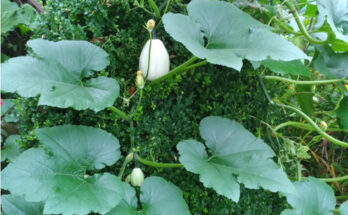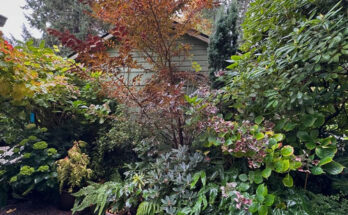The genus Hydrangea provides an excellent alternative for roses due to their lower maintenance needs and unusual traits.
Like roses, hydrangeas (especially Hydrangea serrata) are used in teas and are considered to have health benefits in many cultures.
Unlike roses, the most common hydrangea species can change color.
This fascinating phenomenon often occurs in Hydrangea macrophylla and Hydrangea serrata, and is linked to soil acidity levels.
But something else unusual about hydrangeas is their use in companion planting.
Unlike most plants, companion planting (or complimentary gardening) is rarely done to decrease maintenance on a bed.
Instead, companion planting takes on a far more aesthetic value for hydrangeas.
But if this is the case, what are excellent hydrangea companion plants?
What Are The Best Hydrangea Plant Companions?
There’s something to be said for picking good companions with hydrangeas.
Here are the reasons why the process is unusual, as well as a bunch of plants that work really well with hydrangeas.
Unusual Circumstances
Normally, companion planting is based on grouping plants together so that each plant provides some health benefits to others in the group.
This isn’t the case with hydrangeas, however.
Due to their generally large size, many common companion plants would be unable to grow alongside a hydrangea.
Instead, there are 3 major aspects to be considered when companion planting in this case:
- Aesthetics – Hydrangeas are round plants with round bouquets, so you’ll generally want companions that complement this shape or the bloom colors.
- Lighting – Under most circumstances, you’ll need a foreground plant that can handle shade conditions, although some trees will also work well as a backdrop.
- Pollination – This is the one big factor, as the more pollinators you can draw, the bigger and better the blooms you can achieve.
Note that this list doesn’t include pest or disease control, normally important aspects of companion planting.
However, pollination is an important factor for rather unusual reasons.
Hydrangeas And Pollinators
The relationship between hydrangeas and pollinators is a peculiar one.
The great panicles of flowers you see are pure decoration, with the fertile flowers being small, white, and unremarkable (hidden beneath the more colorful display).
Most hydrangeas provide a veritable feast for bees. Still, many cultivars (the most common in gardens) are sterile, which foraging bees will quickly pick up on and divert their hive mates away from.
As a result, plants that attract pollinators are some of the essential companions you can add to a hydrangea bed.
Excellent Hydrangea Companions
The following plants work well with hydrangea, fulfilling at least two of the 3 criteria for an excellent hydrangea companion and growing in the same conditions as the hydrangea plant.
Astilbe (Astilbe spp.)
With lacy leaves and spiky flowers, astilbes are quite the contrast to hydrangeas, adding a lot of great visual appeal to the bed.
As they’re shade lovers, they grow really well alongside bush plants, with the taller varieties being great mixes in with the hydrangeas.
The regular-sized ones work best in the front row, where their summer-long blooms can thrive from the more dappled sunlight.
Azalea (Rhododendron subsp. Azaleastrum)
When talking aesthetics, it doesn’t get much better than a combined bed of azaleas and hydrangeas.
Azaleas bloom all spring, beginning to fade just as the hydrangeas begin their summer-long bloom cycle.
Another advantage of these plants is their resistance to insect pests, which can carry over to protecting the hydrangeas to some degree.
Campanula (Campanula spp.)
When planted in a manner that gives them the same full sun as hydrangeas, the two plants work amazingly well together.
Campanulas (a type of bellflower) thrive in the same conditions as hydrangeas and have summer-long blooms that begin in June.
Pair the two plants up for the best results with complimentary bloom colors.
Dogwood (Cornus spp.)
As any flowerbed aficionado knows, the best bets are planted in rows, with the tallest plants to the back (or in the middle, if the bed is round) and the smallest serving as borders.
That said, dogwoods vary in size, with the smaller ones enjoying the full morning sun and light afternoon shade, while the taller ones help to give your hydrangeas a bit of that shade.
Another great advantage to dogwoods is that they bloom in May through June, making them a perfect lead-in for hydrangea’s summer display.
Fern
Ferns are wonderful shade-lovers with delicate lacy fronds, providing intricate groundcovers around taller plants such as hydrangea.
As a bonus, many species of fern are edible, help enrich the soil, or even remove toxins from the soil, such as arsenic.
Heuchera (Heuchera spp.)
Now here’s a companion plant with a lot of versatility.
Better known as coral bells, the plant is an excellent groundcover and is often grown just for the foliage.
There are around 37 accepted species, but hybrids are quite common within the genus and a few cultivars.
What makes these such great companies to hydrangeas are high adaptability, ground-level protection for your hydrangea’s roots in winter (heucheras are evergreen), and (when they flower) tall, thin spikes that really compliment the rounded hydrangea blooms.
Hosta (Hosta spp.)
Hostas are one of the most popular ornamental shrubs out there for indoor and outdoor planting, and with good reason.
These shade-loving plants work great around the base of your hydrangeas and add extra visual texture to the bed.
The only downside is that deer love to munch on them, so you should plant deer-resistant plants in front of (or among) the hostas to avoid having your hydrangeas nibbled on.
Nepeta (Nepeta spp.)
More commonly known as catmint, nepeta attracts plenty of pollinators, not to mention the silvery green foliage and summer-long purple spike flowers.
Plant these in front of your hydrangeas where the sun can reach them, and you’ll be rewarded by a pleasant minty smell that may help repel some pests.
Veronica (Veronica spp.)
For a genus containing more than 500 species, Veronica is greatly underappreciated.
The foliage forms in small mounds, making it a great foreground plant for hydrangeas.
The summer-long bloom spikes compliment ball-shaped hydrangea panicles even more impressive.
Other Great Companions
We could go on all day about plants that go great with hydrangeas, but here’s a quick sampling of some inters worth noting:
- Astilbe (Astilbe spp.)
- Conifers
- Daylily (Hemerocallis spp.)
- Gardenia (Gardenia spp.)
- Geranium (Geranium spp.)
- Japanese forest grass (Hakonechloa spp.)
- Japanese maple (Acer palmatum)
- Japanese pieris (Pieris japonica)
- Lamb’s ear (Stachys byzantina)
- Purple coneflower (Echinacea purpurea)
- Rhododendron (Rhododendron spp.)
- Sweetspire (Itea spp.)
Source link
Originally posted 2022-07-22 13:44:54.





